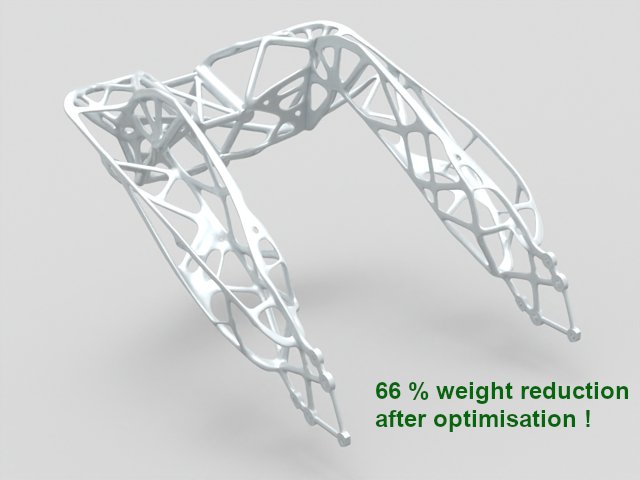Topology optimisation in practice is the development and optimisation of a component based on a given installation space, taking into account a given load profile.
This development process is also called generative design. The example shown here of the topology optimisation of a swing arm used as a mounting for a device was created with the kind permission of the German Aerospace Center (DLR).
Customer requirements for the design of the swing arm
A rotating camera is to be attached to a swing arm to be developed on a solar-powered aircraft that will be in operation in the stratosphere for a long period of time. In addition to the mechanical requirements due to the rotation of the device, influencing factors such as the large temperature differences and UV radiation must also be taken into account for the design of the swing arm. Furthermore, a suitable material and a suitable manufacturing process must be selected for the production of the component.
Our customer's requirement is to minimise the weight of the bracket and maximise the rigidity. The shape should not change as much as possible despite rotation around two axes. The bracket (swing arm) on which the unit is mounted should only allow small movements. Despite the low weight, the stiffness of the component should be designed in such a way that handling and assembly are easy.
Results of the topology optimisation
After the topology optimisation carried out by us on the basis of several simulations, the weight of the swing arm can be reduced by 66% from the desired target weight without any disadvantages in practical handling due to an excessively filigree component structure. The stiffness can also be increased by a factor of 4.

In addition to weight, stiffness and handling of the component, another challenge here is manufacturability. This results in additional requirements for any installation space restrictions and thermal influencing factors in the production of the component. The thermal distortion of a component produced by 3D metal printing should not be underestimated and plays a role especially with correspondingly filigree structures.
When selecting the material due to the required mechanical stiffness and strength, an injection-moulded plastic might have been a good option. However, this approach was rejected for reasons of UV radiation, very low temperatures and insufficient stiffness.
3D printing with metals
A better option for this special application is 3D printing with metals (metal printing or laser sintering). Metals with higher yield strengths and lower stiffnesses are often used here. In addition, it is important to ensure that the original mould is not too large, as larger components not only significantly complicate handling, but also reduce the number of suppliers who can print such a large mould.
A metal with a significantly lower yield strength and a more favourable stiffness can therefore work very well under certain circumstances. The design criteria specified for the functionality of the component (e.g. wall thicknesses, radii or bores) must be taken into account during production. Possible warpage due to the thermal effects that occur during component manufacture must also be taken into account in advance.
For these reasons, it is advisable to map the manufacturing process itself in an additional simulation:
The requirements of our customer are met by topology optimisations carried out in several iteration steps in combination with the simulation of the production.
Thus, we are not only able to take into account corresponding requirements for the structural mechanics of components, but can also help you specifically when it comes to determining and mapping the influences of manufacturing processes and the resulting interaction effects on component strength.
This project was developed in cooperation with our long-term partner Krotwaar Consulting and Engineering B.V. and the German Aerospace Center (DLR).
Are you curious ?
Inform yourself about our complete range of services and contact us !

